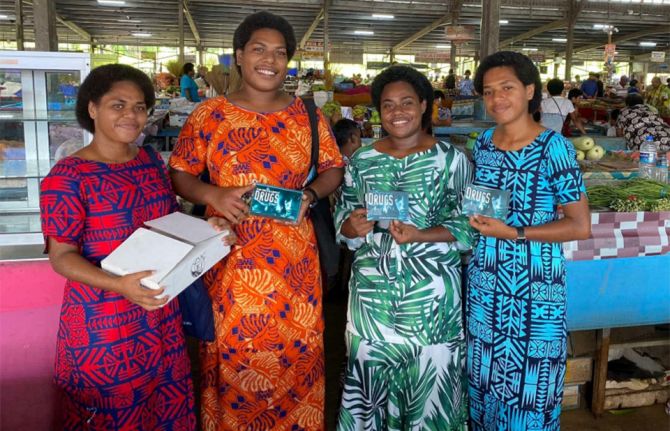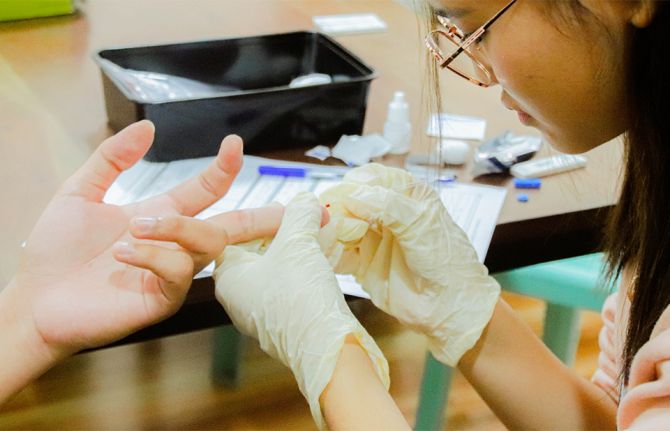
Feature Story
Independent Commission on AIDS in Asia calls for countries to craft new responses
26 March 2008
26 March 2008 26 March 2008
Professor C. Rangarajan (right), Chair of the Commission on AIDS in Asia, presented the report of the Commission to the United Nations Secretary-General Ban Ki-Moon, 26 March 2008.
Photo credit: UN Photo/Mark Garten.
High-impact interventions, such as HIV prevention programmes focused on key populations and antiretroviral treatment, should constitute the core of the HIV response across Asia recommends independent Commission on AIDS in Asia. Their new report, entitled “Redefining AIDS in Asia – Crafting an effective response”, was presented to the United Nations Secretary-General Ban Ki-Moon on 26 March at an event in New York.
The independent Commission on AIDS in Asia was created in June 2006 to give an opportunity to look at the unfolding realities of the HIV epidemic in Asia from a wide socioeconomic perspective reaching beyond the public health context.
In order to deliver on this mandate, nine leading economists, scientists, civil society representatives and policy-makers from across the region were appointed to the Commission which is led by Professor C. Rangarajan, Chief Economic Adviser to the Prime Minister of India.

Press conference by Dr. Chakravarthi Rangarajan, Chairman of the Commission on AIDS in Asia and Chairman of the Economic Advisory Council to the Prime Minister of India (C); Dr. Peter Piot, Executive Director of UNAIDS (R); Ms. Frika Chia Iskandar, Coordinator, Asia Pacific Network of People Living with HIV and AIDS (L) . Photo credit: UN Photo/Mark Garten.
Welcoming the report, Dr Peter Piot, Executive Director of the Joint United Nations Programme on HIV/AIDS expressed his appreciation for the Commission’s efforts to bring a new perspective on the Asian epidemic, including its pragmatic recommendations.
“The findings of this report demonstrate the diversity of the AIDS epidemics in Asia and the need for countries to understand what is driving their epidemics and how to reach populations most at risk of HIV infection,” said Dr Piot.
AIDS epidemics in Asia
While recognizing that epidemics vary considerably from country to country across Asia, the report highlights certain shared characteristics. Epidemics centre mainly around behaviours of unprotected paid sex, use of contaminated needles and syringes by people who inject drugs, and unprotected sex between men. The Commission observes that the current classification of the epidemic as “low, concentrated and generalised” is inducing a sense of complacency among Asian Governments. The Commission urges UNAIDS and WHO to recommend a new classification based on the risk factors and burden of disease for low and concentrated epidemic countries.
The commission identified that in Asia the HIV epidemic is mainly driven by men who go for paid sex. Their number is estimated to be about 75 million in Asia and about 10 million women sell sex to these men. However the further transmission of the virus is limited by the sexual behaviour of women in an Asian context who generally do not have concurrent sexual partners.
So, by pragmatically focusing prevention programmes to the sex trade and on drug use, the commission suggests a considerable impact could be made by governments in halting and reversing the number of new infections across this region.
National response to HIV
The report acknowledges that effective and focused responses are underway in Cambodia, Thailand and parts of India but finds a lack of urgency or coherence in the response in many countries which is not enough to curb their epidemic. Heads of Governments of Asian countries should assume stronger leadership role, as according to the report in only two countries have they played a prominent role and officially provided leadership to the national AIDS programme.
To address concentrated epidemics requires leadership to overcome the social drivers behind the epidemic. These include structural and social factors, such as criminalization and marginalization of certain groups, human rights violations and discrimination. Failing to address these constitutes a major barrier to an effective national response.
Policy recommendations

In order to address this, the report makes a series of strong recommendations for national governments around leadership, resource commitment, strategic information and community involvement.
Recommendations include the need for government and business leaders to assume a more proactive role in the HIV response and that community and civil society involvement should be ensured at all stages of policy, programme design, implementation and monitoring and evaluation.
Focusing on maximizing results, the report suggests specific government actions on prevention, treatment and care services. It recommends that impact mitigation programmes should be core to a national AIDS response and recommends better national monitoring and evaluation of epidemiological, behavioural and financial data in order for countries to acquire better knowledge of the epidemics and to determine the effectiveness of various strategic options.
Call for concerted and focused political will
Over an 18-month period, the Commission held five sub-regional and regional consultations, meeting more than 30 experts and 600 individuals and governmental and civil society groups, as well as reviewing more than 5,000 published and unpublished studies. Through its review and consultations with a broad range of stakeholders, the Commission has produced this set of findings and recommendations.
Nearly five million people are living with HIV in Asia with 440,000 people dying each year. If the current rate of transmission continues, the study contends, an additional eight million people will become newly infected by 2020.
The Commission on AIDS in Asia believes that governments in Asia have the potential to make the ambitious international targets–2001 Declaration of Commitment on HIV/AIDS as well as Millennium Development Goal 6 to halt and reverse the epidemic by 2015– a reality if they take the decisive steps set out in this new report.
Independent Commission on AIDS in Asia calls for
Press centre:
Read speech by United Nations Secretary-General
AIDS remains the leading cause of death and lost work days in the most productive age groups in Asia (26 March 2008)
Multimedia:
Webcast of the Press Conference: "Redefining AIDS in Asia – Crafting an Effective Response"
View photo gallery
Publications:
Download full report - Redefining AIDS in Asia: Crafting an effective response (pdf, 1.6 Mb)
Fact sheets Part 1 (pdf, 4 Mb)
Fact sheets Part 2 (pdf, 4 Mb)



